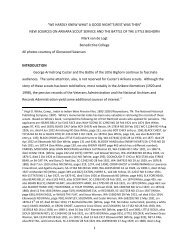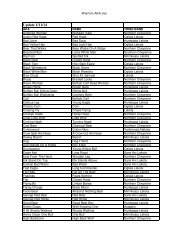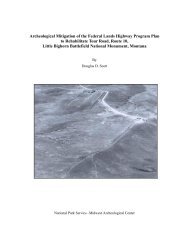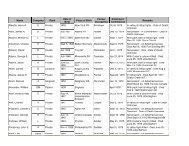Investigating the Oxbows and Testing Metal Detector Efficiency
Investigating the Oxbows and Testing Metal Detector Efficiency
Investigating the Oxbows and Testing Metal Detector Efficiency
You also want an ePaper? Increase the reach of your titles
YUMPU automatically turns print PDFs into web optimized ePapers that Google loves.
avine opens on to a broad floodplain that is covered in sagebrush <strong>and</strong> grasses (Figure 5). This<br />
sagebrush flat fades into a densely vegetated ra<strong>the</strong>r large oxbow that is irregularly shaped by<br />
river me<strong>and</strong>ers. The dense vegetation is composed of thick underbrush, cottonwood trees, <strong>and</strong> a<br />
good deal of fallen or down trees <strong>and</strong> large tree limbs.<br />
Figure 5. <strong>Metal</strong> detector team at work at <strong>the</strong> mouth of Deep Ravine. Note <strong>the</strong> dense vegetation on <strong>the</strong> main<br />
oxbow to <strong>the</strong> left of <strong>the</strong> sagebrush area.<br />
The sagebrush flat <strong>and</strong> <strong>the</strong> mouth of <strong>the</strong> ravine were inventoried in 1984 with no battle-related<br />
items recovered in this area (Scott <strong>and</strong> Fox 1987). The Deep Ravine oxbow was detected in a<br />
manner similar to that of <strong>the</strong> south oxbow. The sagebrush flat yielded an unidentified iron bar, 11<br />
.22-caliber fired cartridge cases, 2 .22-caliber bullets, <strong>and</strong> a .45-70-caliber cartridge case with a<br />
WRA headstamp. The .22-caliber cartridge cases were headstamped with an impressed U or a<br />
diamond. The U st<strong>and</strong>s for Union <strong>Metal</strong>lic Arms Company <strong>and</strong> is still used today by <strong>the</strong>ir<br />
successor Remington Arms. The impressed U was first used in <strong>the</strong> 1880s but became common<br />
on .22-caliber ammunition after 1910 when Remington purchased UMC, <strong>and</strong> <strong>the</strong> U became <strong>the</strong>ir<br />
logo. The WRA headstamp is for Winchester Repeating Arms <strong>and</strong> was <strong>the</strong>ir headstamp from<br />
1929 to 1978 (Shuey 1999:9-12).<br />
The dense vegetation precluded all but <strong>the</strong> most r<strong>and</strong>om metal detector sweeps as <strong>the</strong> team could<br />
not swing <strong>the</strong> detectors nor reach <strong>the</strong> ground surface with <strong>the</strong> coils in most areas. The r<strong>and</strong>om<br />
detector sweeps of <strong>the</strong> heavily vegetated areas produced two metal targets found with PI<br />
11








